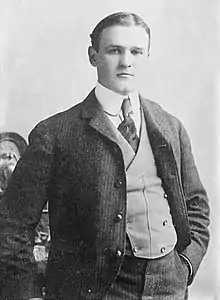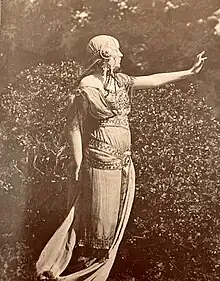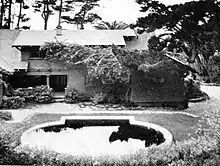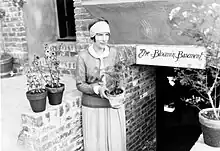Helen MacGowan Cooke
Helen MacGowan Cooke (December 28, 1895 – July 14, 1945) was an American actress best known for her marriage to the acclaimed writer Harry Leon Wilson. Cooke was the daughter of writer Grace MacGowan Cooke. She appeared on stage at the Forest Theater, captivating audiences with her performances in notable plays of the time.[1]
Helen MacGowan Cooke | |
|---|---|
 Helen Cooke picking California golden poppies (1908) | |
| Born | December 28, 1895 Chattanooga, Tennessee, U.S. |
| Died | 14 July 1945 (aged 49) Washington D.C., U.S. |
| Occupation | Actress |
| Years active | 1910-1926 |
| Spouses | |
Early life

Cooke was born in Chattanooga, Tennessee, on December 28, 1895. Her father was William Benjamin Cooke (1857-1928) and her mother was writer Grace MacGowan (1861-1944), the niece of writer Alice MacGowan. Cooks's younger sister Katherine "Kit" Ignacia Cooke (1900–1971) was born on January 17, 1900.[2][3] In 1906, Helen and Katherine, and their mother moved the Helicon Home Colony in Englewood, New Jersey. Her mother, Grace, had left her husband at this time.[4]
In December 1908, Helen and Katherine, and their mother moved to the art colony at Carmel-by-the-Sea, California, which included such influential figures as Mary Hunter Austin, Jack London, Upton Sinclair, George Sterling, Francis McComas, Xavier Martinez, Sinclair Lewis, and Nora May French.[5] The same year, the family moved into a large, Tudor-style two-story house on San Antonio and 13th Avenues, one of the first homes constructed in southwest Carmel, built in 1905 by architect Eugenia Maybury, one of Carmel's first female architects.[6][7][8]
During the year 1908, Arnold Genthe captured a photograph of Cooke amidst a poppy field located near Carmel. The resulting piece, titled Helen Cooke, Monterey Poppy Field (1908), exemplifies the composition of Pictorialism, an early use of color. The photograph is an example of Autochrome, an early technique for capturing color. In the image, Cooke is dressed in attire reminiscent of the Pre-Raphaelite style. During that period, both Genthe and Sinclair Lewis had deep affection for Cooke.[9]
Such a prosaic thing as wedded love has come to Carmel-by-the-Sea. The scintillating, rarified atmosphere of this literary hothouse of the Pacific has met with a new thrill-atremble of persistent, world-old music that pounds upon the shores of humanity as the waves sing upon the yellow beach.[1]
— The San Francisco Examiner
On June 4, 1912, Cooke, at the age of 18, married Harry Leon Wilson (1867–1939) at the Hotel Steward in San Francisco. They had two children Harry Leon Wilson Jr. in 1913 and Charis Wilson in 1914.[4][1] Her daughter, Charis Wilson was a model, writer, and wife of photographer Edward Weston. She was also a subject of Weston's photographs.[10]
Two years later, someone attempted to murder her aunt, Alice MacGowan, by poison and to steal her diamonds and cash. Wilson and writer Jimmy Hopper became amateur detectives, but the perpetrator was never discovered.[5]
Career

During the early 1910s, Cooke showcased her artistic versatility by venturing into the realm of acting. She went to the stage of the Forest Theater, performing in notable plays of the time. In July 1910, at the age of fifteen, Cooke took on the role of Michal, opposite actor Herbert Heron, in the production of David. The play, a six-act biblical drama, was produced by Constance Skinner and directed by Garnet Holme of Berkeley. It marked a significant milestone as the inaugural production at the Forest Theater. Kit's portrayal of Michal showcased her talent and marked the beginning of her acting journey.[11][12][13][5]
Continuing her foray into the theatrical world, in July 1912, Cooke participated in The Toad, a play written by Bertha Newberry, the wife of Perry Newberry, and produced by Garnet Holme. This production provided Cooke (Helen Cooke Wilson) with another opportunity to showcase her acting prowess, immersing herself in a captivating role of Cleis, the Seeress of Amon, that further demonstrated her range as a performer.[13]
In August 1914, The Arrow Maker was produced by Mary Hunter Austin at the Forest Theater. Cooke (Helen Cooke Wilson) played an Indian woman and her sister, Katharine, played Yavi, an Indian boy. Author Charlotte Kellogg, wife of biologist Vernon Lyman Kellogg played Chisera in the play. Novelist Harry Leon Wilson played Bright Water and Padahoon was played by writer John Northern Hilliard.[13][14]
In June 1921, Cooke was cast in the role of Madame Lucie Lachesnais and her sister Katharine directed and oversaw the stagecraft for the play Pomander Walk, by Louis N. Parker, at the Forest Theater.[15][16] The production received outstanding reviews overall, although there were a few objections due to the play being performed on a Sunday. In 1922, Wilson accused his Carmel Highlands neighbor, painter Theodore M. Criley of flirting with his wife, Helen, while they worked together on the play in his role of John Sayles, the 10th Baron of Otford. Wilson issued a challenge to him, resulting in a duel that took the form of a fistfight at Yankee Point. Criley emerged victorious from the encounter. This incident made its way into The New York Times.[4][17]
With her appearances at the Forest Theater and the Carmel Arts and Crafts Club, Cooke not only demonstrated her dedication to her craft but also solidified her presence in the theatrical community. Her performances in plays such as David and The Toad highlighted her ability to breathe life into complex characters, captivating audiences with her talent and stage presence.[13]
These early theatrical experiences served as stepping stones for Cooke, paving the way for her future artistic endeavors. Her contributions to the stage added a new dimension to her already impressive creative repertoire.
Move to Carmel Highlands


The family moved from Carmel to Carmel Highlands where Wilson built a large home he called "The Ocean Home." The home had 12 rooms on 8 acres (3.2 ha) of land and was completed in 1912.[4]
In 1925, Wilson commission Lee Gottfried to build a two-story commercial building for his wife, Helen, who ran a flower shop called the Bloomin' Basement. It was in front of the two-story Golden Bough Theater on Ocean Avenue and Monte Verde Street in downtown Carmel. It later became a popular Bohemian bar and restaurant, Sade's (now Porta Bella).[18] The shop was built for $8,000 (equivalent to $133,495 in 2022).[19][20][21] The Bloomin' Basement was an enlarged version of the original shop she started in 1924 in the basement of the corner Amelia Gates Building located at Ocean and Monte Verde.[22]
Cooke and Wilson divorced in 1927. Both children were raised by their aunt, Katharine Cooke, grandmother, Grace MacGowan Cooke, and a great aunt.[4][23]
A severe auto accident in 1932 greatly affected Wilson's health during his remaining years. He died of a brain hemorrhage on June 28, 1939, while residing with friends at Carmel Point. He was 72 years of age.[24]
Divorce and new relationship
Following her divorce, Cooke embarked on a new venture by opening a dress shop named "The Carmelita Shop," where the Bloomin' Basement was, and later Sade's, facing the Court of the Golden Bough on Ocean Avenue in Carmel.[19] The shop catered to the fashion-conscious clientele, offering a curated selection of garments. However, the timing proved unfortunate, as the Great Depression cast its shadow over the nation, leading to economic hardships for many businesses. Sadly, Cooke's dress shop fell victim to the challenging economic climate and eventually closed its doors.[4]
In 1934, fate intervened when Cooke crossed paths with Colonel Paul E. Peabody, stationed at the Monterey Presidio. Their meeting sparked a connection that would soon blossom into a deep and lasting relationship. The following year, in 1935, Cooke made a significant decision and relocated to Washington D.C., where Colonel Peabody had been transferred. In Washington D.C., Cooke and Peabody forged a strong partnership based on love and married, solidifying their commitment to one another.[4]
Death
Tragically, Cooke faced a daunting battle with cancer, a battle she ultimately succumbed to. She found herself in the care of Walter Reed General Hospital, now known as Walter Reed Army Medical Center, located in Washington D.C. In July 1945, at the age of 49, she passed away at Walter Reed General Hospital.[4] Funeral services were held at Walter Reed Chapel. Burial was private.[25][11]
Plays
- David (1910)
- The Toad (1912)
- The Arrow Maker (1914)
- Pomander Walk (1921)
See also
References
- "Harry Leon Wilson Marries Young Gir". The San Francisco Examiner. San Francisco, California. June 14, 1912. p. 1. Retrieved June 29, 2023.
- "Cooke-MacGowan. The Marriage of Wm. B. Cooke and Miss Grace MacGowan". The Chattanooga Commercial. Chattanooga, Tennessee. February 18, 1887. p. 8. Retrieved October 15, 2022.
- "Grace MacGowan Cooke dies at Los Gatos". The Peninsula Times Tribune. Palo Alto, California. June 26, 1944. p. 83. Retrieved June 30, 2023.
- Dramov, Alissandra (2012). Carmel-by-the-Sea, The Early Years (1803-1913). pp. 172–173. ISBN 9781491824146. Retrieved March 3, 2023.
{{cite book}}:|work=ignored (help)CS1 maint: location missing publisher (link) - Edwards, Robert W. (2012). "Chapter Two – Western Frontiers: Birth of the Carmel Art Colony (1896-1909)". Jennie V. Cannon: The Untold History of the Carmel and Berkeley Art Colonies (PDF). p. 39. ISBN 978-1467545679. Retrieved April 7, 2023.
{{cite book}}:|work=ignored (help)CS1 maint: location missing publisher (link) - Dramov, Alissandra (2016). Historic Homes and Inns of Carmel-by-the-Sea. p. 40. ISBN 9781439656747. Retrieved April 8, 2023.
{{cite book}}:|work=ignored (help) - "Carmel Historic Inventory" (PDF). ci.carmel.ca.us. Carmel, California. Retrieved March 29, 2022.
- Dramov, Alissandra (2022). Past & Present Carmel-By-The-Sea. Charleston, South Carolina: Arcadia Publishing. p. 91. ISBN 9781467108980. Retrieved March 8, 2023.
- Starr, Kevin (2022). The Dream Endures California Enters the 1940s. Oxford: Oxford University Press. ISBN 9780199923939.
- Starr, Kevin (2022). The Dream Endures California Enters the 1940s. Oxford: Oxford University Press. ISBN 9780199923939.
- "Mrs. Paul Peabody". Carmel Pine Cone. Carmel-by-the-Sea, California. September 9, 1945. pp. 1–2. Retrieved July 1, 2023.
- "Biblical Drama Is Given Under Garmel Pines". The San Francisco Examiner. San Francisco, California. July 10, 1910. p. 3. Retrieved August 3, 2022.
- "Forest Theater Plays". Harrison Memorial Library. Carmel-by-the-Sea, California. 1910. Retrieved June 22, 2022.
- "'The Arrow-Maker' Produced At Carmel". San Francisco Chronicle. San Francisco, California. July 26, 1914. p. 33. Retrieved July 3, 2023.
- "Carmel To Give Pomander Walk". The San Francisco Examiner. San Francisco, California. June 26, 1921. Retrieved July 2, 2023.
- "Carmel Rows Over Forest Theater Play". The San Francisco Examiner. San Francisco, California. September 16, 1921. p. 8. Retrieved July 2, 2023.
- "Harry Leon Wilson". Contemporary Authors Online. Gale Group. 2010. Retrieved April 8, 2010.
- Dramov, Alissandra (2019). Historic Buildings of Downtown Carmel-by-the-Sea. Carmel-by-the-Sea, California: Arcadia Publishing. pp. 62, 77. ISBN 9781467103039. Retrieved April 4, 2022.
- Scott Bearton (September 9, 1994). "A look back at Sade's colorful past". Carmel Pine Cone. Retrieved April 7, 2022.
- "The Bloomin Basement Court of the Golden Bough". Carmel Pine Cone. June 21, 1924. p. 7. Retrieved April 7, 2022.
- Dramov, Alissandra (2022). Past & Present Carmel-By-The-Sea. Charleston, South Carolina: Arcadia Publishing. p. 16. ISBN 9781467108980. Retrieved March 8, 2023.
- Neal Hotelling (March 4, 2022). "'Embrassing' duel at Yankee Point" (PDF). Carmel Pine Cone. pp. 23, 26. Retrieved July 5, 2023.
- "Mrs. Harry Leon Wilson Begins Suit". The San Francisco Examiner. San Francisco, California. August 31, 1927. p. 3. Retrieved June 30, 2023.
- "Famed Author Is Dead at Carmel". Napa Journal. Napa, California. June 30, 1939. p. 6. Retrieved July 19, 2022.
- "Mrs. Peabody Rites Held At Walter Reed Chapel". Evening Star. Washington, District of Columbia. July 16, 1945. p. 10. Retrieved June 29, 2023.